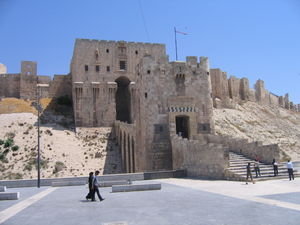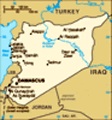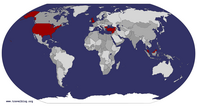Advertisement
Published: June 17th 2008

 Aleppo Citadel
Aleppo Citadel
the imposing fortafied keep is the entrance to the citadel"30 SECOND RULE! 30 SECOND RULE!"
I shouted as Jen and I scrambled to rescue the Goldfish crackers that had spilled all over the floor...
We arrived at the Syrian border around 11:00 in the morning, Friday the 13th, unsure of how the day would play out. Technically, US passport holders are supposed to jump through a lot of hoops (and spend a lot of money in the process) in order to get tourist visas for Syria. We decided to skip all the red tape and formalities and to rely instead on our charm and good looks.
The ride to the border, courtesy of Kadir's father (thanks so much!), took us through a landscape of fields decorated with occasional rocky mountains under a hot morning sun. We were promptly stamped out of Turkey and away from familiar languages. On the Syrian side, it didn't take long for somebody to understand our situation and to point us in the correct direction.
We were taken to a typical, sort of dingy office. A somewhat friendly border official who spoke a tiny bit of English filled out our forms for us in Arabic, asking a few standard questions about the purpose

 Norias
Norias
This is one of the norias in Hama. Some neighborhood boys were eager to show off their daring skills at this one. They helped to illustrate the immense scale of the wheels.of our trip. This did not take too long and he explained that they would have to fax Damascus to see whether or not we could be given visas.
"Two or three hours... wait over there."
I assumed that that meant five hours. We sat down and looked up at a sign covered in Arabic with four large words written in English at the bottom: Hope You Happy Travel.
Jen wisely packed a chess/backgammon board and before too long we made good use of it. We had plenty of bottled water but our food resources were limited to a box of börek, courtesy of Kadir's mother (thanks so much!), some cookies, and a bag of Goldfish crackers. The Goldfish became our most prized item after we had stuffed ourselves repeatedly on cookies and room-temperature börek.
About seven hours into the wait, my clumsy foot tipped over the Goldfish bag sending our precious remaining supply, to our horror, all over what obviously wasn't the world's cleanest floor. Feeling in many ways utterly defeated, we refused to let the crackers go and even saved many of the larger and mid-sized crumbs. This is how traveling works sometimes...

 Musyaf
Musyaf
Unfortunately we weren't able to get pictures of the entire castle from a distance - the thing is massive!!! This angle is part of the inside.About ten hours into the wait we learned that the fax had arrived, and, amazingly, that we would be let in if we could each pay 16 USD for visas. We were elated. This began a process of running from counter to counter, unsure really of what was going on, but being given encouraging pieces of paper at times. Eventually I ended up with what looked like five postage stamps for each of us, hoping that these actually were the visas. They indeed were and eventually somebody arranged them into a triangle and glued them into our passports - one of the more peculiar visas I've ever seen.
Welcome to Syria!!!
After hearing a few outrageous quotes of $50 for a taxi to Aleppo from the border, we agreed to pay $30 to a friend of a man who had been helpful and given us tea during the final moments of sorting out the visas. Mistakenly, we didn't actually reconfirm this price with the actual driver before he set off (schoolboy error) and after a kilometer or so the argument about payment began in very broken Turkish. We settled on $40 after a lot of bad noise and
the rest of the journey was more pleasant after that as we watched the exotic Syrian night pass by our windows. We were dropped off at the doorstep of the hostel that we had requested and we were too thrilled about actually finishing the evening on the Syrian side of the border to be upset about the rip-off.
We hung out at the pleasant hostel, e-mailed our families ("dear mom, I'm a little bit in Syria right now..."),and met two interesting travelers. Ana, a hilarious chap from Holland is on his way back from an overland adventure to and from India - he was bummed that he couldn't get an Afghani visa in Peshawar. Sara, a young, white, pretty American girl is currently living in Aleppo, learning Arabic. She has traveled Northern Africa and the Middle East extensively and raves about all corners of the Arabic-speaking world. Next month she will return to Yemen for a full month, a brave thing to do in July. Sara, for me, symbolizes just how warped American perceptions truly are of this hospitable part of the world. If she can emerge from these lands smiling, unscathed, and eager for more, well, just about
anyone could.
Following the suggestions of Ana and Sara, we began our full day in Aleppo with some superb freshly-mixed juice and panini-esque sandwiches. Our bellies filled for a fraction of what we'd pay for something similar in Turkey, we headed off for a day of exploring.
Aleppo has been continuously-inhabited for roughly eight thousand years, making Istanbul seem like a mere toddler.
We started at the impressive Aleppo Citadel which towers above the old city and is surrounded by an enormous (though now dry) moat. The fortified keep, supported by many arches, is the entrance to the citadel and probably the most familiar image of Aleppo. Inside there is a lot of construction going on, but still plenty to see, including a large amphitheater, some mosques, other buildings and the massive structure connected to the entrance. Inside we met a handful of friendly, smiling Bangladeshi tourists - how cool is that! - and chatted with them briefly.
Later on in the day we paid a visit to the Great Mosque, which had originally been built in 705-717 A.D. It has been destroyed and rebuilt many times since then. I found its massive courtyard to be more impressive than the mosque itself, though after so many months in Turkey it faced some unfairly stiff competition. This would be the first of several tourist mosques where Jen was required to wear a baggy cloak-thingy, which made her look like she was preparing to do some finger-painting.
We wandered in and out of the bewildering "souq" (Arabic for "bazaar") throughout the day. It has been the place to buy spices, rope, knives, meat, clothing, jewels, and probably just about anything else anyone could ever need since the 13th century, though most of the covered portions of it were built during Ottoman times (16th-19th centuries). Unlike the enormous Grand Bazaar in Istanbul (which I think might even be smaller than the Aleppo souq!), this one seems to cater completely to the needs of everyday life. It is filled with the hustle and bustle and charm that you would expect to find watching an old movie set in a Middle Eastern market - except it's real.
We had an exquisite late lunch on a rooftop, still pinching ourselves in disbelief that we were actually in Syria. In the evening we returned to the Citadel, and Jen taught me how to take better night pictures with my camera. I'm still learning though, so none of them made it to this entry.
Leaving Aleppo was a breeze the next morning. On the way to the bus stand people were eager to help us on our way and wish us well for our journey. We found a bus leaving immediately for Hama and parted with about $2 a piece for intercity tickets on a comfortable bus. The flight attendant brought us chocolates.
Hama turned out to be too big of a city to be called "quaint" but still it is less hectic than Aleppo. The Orontes River that flows through the city resembles motionless split-pea soup more than it does a river, but this is (hopefully) because it is diverted to irrigation projects during parts of the year. Still, the murky green gunk did take away from Hama's main tourist sites, the "norias." These are massive water wheels which, back in the day, serviced an intricate aqueduct system, much of which still stands in attractive cobblestone arches around the city.
Their construction began in the 5th century A.D. The norias visible today were built by the Ayyubids in the 13th century. They made about thirty of them, seventeen of which still stand (they also stand still, with the river so low...) We feasted next to the Four Norias of Bechriyyat, supposedly the most impressive part of the collection, but I found it to be a bit underwhelming.
After that: ICE CREAM!
The next morning (Monday, at this point) we stocked up on strawberries, peaches, and water, and departed on a tour organised by our hotel. Like everything seems to be in Syria (except for taxis from the border), all of this was inexpensive.
Our first stop was Musyaf, which earned more "wows!" from everyone in our van (including a sweet Icelandic couple - people come from everywhere to visit Syria...). There was some sort of a castle there when the Crusaders seized it in 1103, but they made it bigger. They in turn lost it to the Ismailis (a Shiite sect known as the "Assassins") in 1140. By the end of the 13th century it would change hands once again and fall under the control of the Syrian Sunnis. The museum that stands today is incredible and we practically had to run through it in order to get back out in forty-five minutes.
Our next stop was the Church of St. George, a Syrian Orthodox church set in some rolling, green hills. Fun fact: Syrian Orthodox churches have pews, unlike many of the Slavic Orthodox churches. The St. George was tidy and attractive and it afforded us a view of the Krak Des Chevaliers castle off in the distance, our ultimate destination.
Oh, and what a destination it would prove to be...
The Krak Des Chevaliers has easily made its way to my personal top ten list - it's up there with the likes of Angkor Wat, Tikal, the Hagia Sofia, and the Taj. Thomas Edward Lawrence ("of Arabia") described it as "the finest castle in the world" and I've so far seen nothing that would make me disagree with that statement. It is hard to express how truly massive and grand it is.
It's construction began in 1031 and by the mid-12th century what stands today had been completed by Crusaders. Despite many sieges, the castle was never breached. Eventually the Christians retreated and simply abandoned the masterpiece. Thirteen huge towers comprise the outer wall. The wall is itself a castle, filled with more rooms than we had time for exploring. Inside, a stunning fortress rises to great windy heights. Two hours proved to be totally inadequate for visiting it and we didn't come close to seeing it all. I will leave you with that inadequate description and a promise to post more pictures when I get back to Istanbul and faster internet connections.
Advertisement
Tot: 0.065s; Tpl: 0.012s; cc: 12; qc: 28; dbt: 0.0339s; 1; m:domysql w:travelblog (10.17.0.13); sld: 1;
; mem: 1.1mb










Masha!
non-member comment
I have yet to meet an unfun Dutchie.